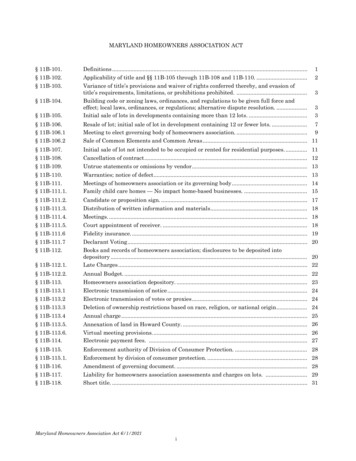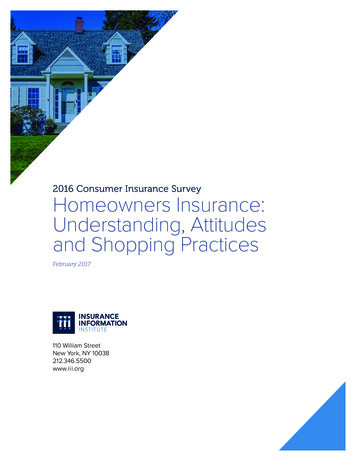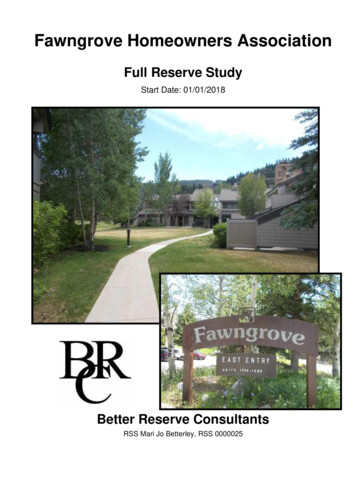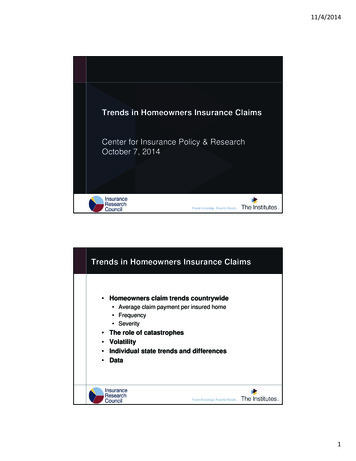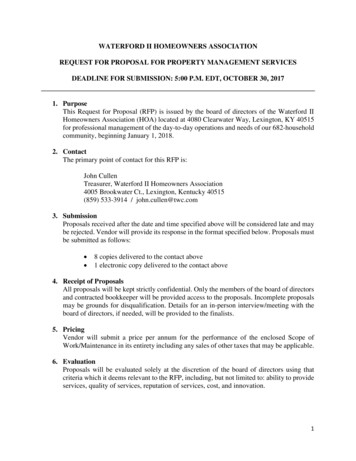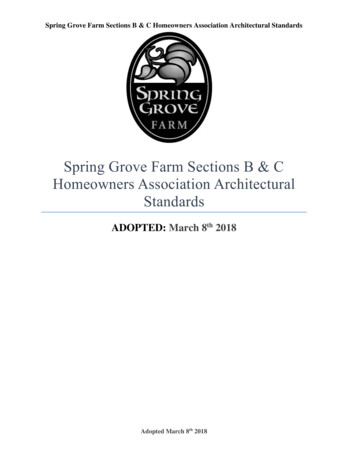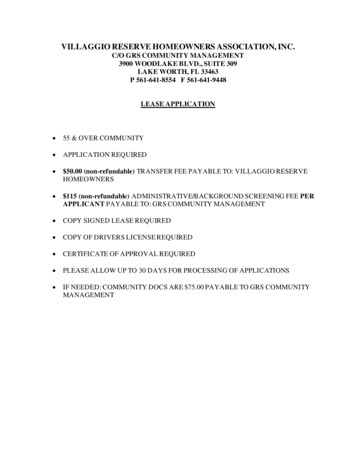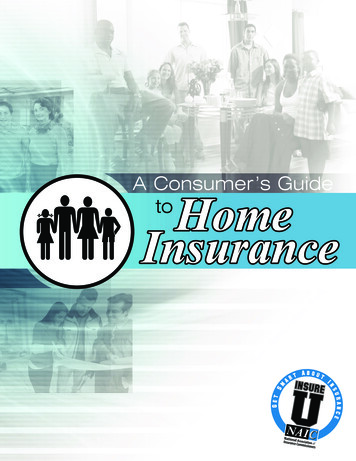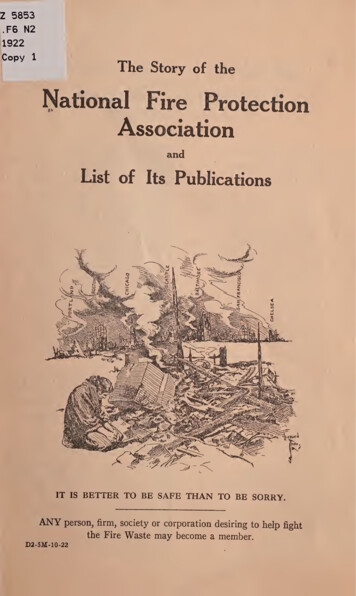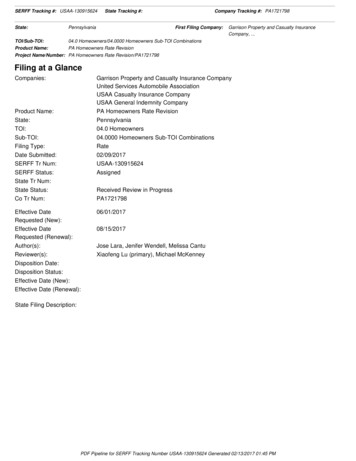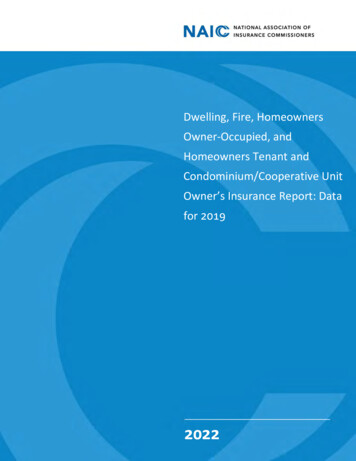
Transcription
Dwelling, Fire, HomeownersOwner-Occupied, andHomeowners Tenant andCondominium/Cooperative UnitOwner’s Insurance Report: Datafor 20192022
The NAIC is the authoritative source for insurance industry information. Our expert solutions support the effortsof regulators, insurers and researchers by providing detailed and comprehensive insurance information. The NAICoffers a wide range of publications in the following categories:Accounting & ReportingInformation about statutory accounting principles andthe procedures necessary for filing financial annualstatements and conducting risk-based capitalcalculations.Special StudiesStudies, reports, handbooks and regulatory researchconducted by NAIC members on a variety of insurancerelated topics.Consumer InformationImportant answers to common questions about auto,home, health and life insurance — as well as buyer’sguides on annuities, long-term care insurance andMedicare supplement plans.Statistical ReportsValuable and in-demand insurance industry-widestatistical data for various lines of business, includingauto, home, health and life insurance.Financial RegulationUseful handbooks, compliance guides and reports onfinancial analysis, company licensing, state auditrequirements and receiverships.Supplementary ProductsGuidance manuals, handbooks, surveys and research ona wide variety of issues.LegalComprehensive collection of NAIC model laws,regulations and guidelines; state laws on insurancetopics; and other regulatory guidance on antifraud andconsumer privacy.Capital Markets & Investment AnalysisInformation regarding portfolio values and proceduresfor complying with NAIC reporting requirements.Market RegulationRegulatory and industry guidance on market-relatedissues, including antifraud, product filing requirements,producer licensing and market analysis.White PapersRelevant studies, guidance and NAIC policy positions ona variety of insurance topics.NAIC ActivitiesNAIC member directories, in-depth reporting of stateregulatory activities and official historical records ofNAIC national meetings and other activities.For more information about NAICpublications, visit us at:http://www.naic.org//prod serv home.htm 2022 National Association of Insurance Commissioners. All rights reserved.ISBN: 978-1-64179-178-6Printed in the United States of AmericaNo part of this book may be reproduced, stored in a retrieval system, or transmitted in any form or by any means, electronic ormechanical, including photocopying, recording, or any storage or retrieval system, without written permission from the NAIC.NAIC Executive Office444 North Capitol Street, NWSuite 700Washington, DC 20001202.471.3990NAIC Central Office1100 Walnut StreetSuite 1500Kansas City, MO 64106816.842.3600NAIC Capital Markets& Investment Analysis OfficeOne New York Plaza, Suite 4210New York, NY 10004212.398.9000
Dwelling Fire, Homeowners Owner-Occupied, and Homeowners Tenant andCondominium/Cooperative Unit Owners Insurance: Data for 2019Table of ContentsPurpose of Report. 1Data . 1Limitations on the Data . 2Residual Market Data . 3Policy Forms/Types. 3Analysis of the Data . 4Factors Affecting the Cost of Insurance . 8Geographic Area, Real Estate and Construction Costs. 8Catastrophe Exposure . 8Mold Damage . 12Terrorism . 12Other Variables . 13Summary. 14Table 1: 2019 House-Years by State and Countrywide by Policy Type . 15Table 2: 2019 House-Years by State and Countrywide by Policy Form . 19Table 3: 2019 House-Years by State and Countrywide by Amount of Insurance. 23Table 4: 2019 Average Premium by Policy Form by Amount of InsuranceDwelling Fire and Homeowners Owner-Occupied Policy Forms . 31Table 5: 2019 Average Premium by Policy Form by Amount of InsuranceHomeowners Tenants and Condominium/Cooperative Unit Policy Forms. 137 2022 National Association of Insurance Commissioners
2022 National Association of Insurance Commissioners
Dwelling Fire, Homeowners Owner-Occupied, and Homeowners Tenant andCondominium/Cooperative Unit Owners Insurance: Data for 2019Market Distribution and Average Cost byPolicy Form and Amount of InsurancePurpose of ReportThis report provides countrywide and state-specific premium and exposure information for noncommercial dwelling fire insurance and for homeowners insurance package policies. Homeownerspackage policy data are for the homeowners owner-occupied policy forms (HO-1, HO-2, HO-3, HO-5 andHO-8), the tenant policy (HO-4) and the condominium/cooperative unit owner’s policy (HO-6). Thisnarrative describes the data and discusses the way economic, demographic and natural phenomenaimpact the price of homeowners insurance.DataData consist of written exposures, expressed as house-years, 1 and aggregate written premiums by stateand countrywide for the 2019 data year. Premium and exposure information was collected for all statesand the District of Columbia. The data are displayed in five tables. Three tables show individual state andcountrywide exposures grouped by 1) policy type; 2) individual policy form; and 3) amount of insurancecoverage, divided into ranges, with percentages of total exposures provided. The last two tables displayby-state and countrywide average premiums. Average premiums are calculated by dividing premiums byexposures for each policy form and range of insurance coverage and represent the cost of a year ofcoverage. Percentages of totals are provided.Policy forms included in the report are described in detail in the following section. The ranges of insuranceamounts extend to higher levels of coverage for the dwelling fire and homeowners owner-occupied policyforms than those for the tenant and condominium insurance, because premiums for the latter two policyforms do not include coverage for the residential structure.To the extent that data are reported to statistical agents, data for statutorily established FAIR plans areincluded.This report is not comprehensive of all statistical agents as there may be smaller statistical agents that donot report data to the NAIC. The data is limited to what was provided by the following companies, whosecooperation and assistance in compiling this report is greatly appreciated: Data for all states, except Texas and California, were provided by the American Association ofInsurance Services; ISO Data, Inc.; the National Independent Statistical Service; IndependentStatistical Service, Inc. (ISS); and the Mutual Service Office (MSO).One house-year represents policy coverage on a dwelling for 12 months. Most often, it consists of coverage for one policy foran entire 12-month period, but it may also represent a number of policies for which the combined lengths of coverage total 12months (e.g., four policies, each with three months of coverage).1 2022 National Association of Insurance Commissioners1
Texas data were obtained from the Texas Department of Insurance. Historically, the Texasdepartment developed its own home insurance policy forms that are similar, but not identical, tohomeowners policy forms countrywide. Although, starting in 2002, insurers were permitted to filetheir own independent forms, some companies continue to use the forms previously promulgatedby the department. California data were provided by the California Department of Insurance. The state begancollecting homeowners data in 1998, starting with the 1996 data year.Limitations on the DataAverage premium is an imperfect measure of the relative “price” of insurance due to wide variations inhazards, economic conditions, and real estate values from state to state. Even when comparing identicalpolicy forms and amounts of insurance, premiums for homeowners coverage can differ dramatically acrossthe country. These market differences are explored in more detail in a later section of this narrative.Premium for a homeowners policy is determined by the amount of insurance purchased (generally basedon the value of the insured property), the types of property covered, the types of perils covered, and thespecific limits and deductibles a policyholder chooses.Averages developed for this report reflect all these variables and more. For each state, some generalassumptions can be made about the types of insurance policies sold, the value of property insured, andpolicyholders’ cost for loss protection for residential property and personal belongings. 2022 National Association of Insurance Commissioners2
Residual Market DataBeginning with the 2011 data year, this report has sought to include data directly from residual marketmechanisms. These mechanisms serve as a state’s insurer of last resort and/or to write high-risk policies,such as wind-only supplemental policies. When possible, complete policies and supplemental policieswere either categorized as the form number associated with the underlying policy or in accordance withthe residual market mechanism’s criteria. If the underlying policy was unavailable, the supplementalpolicies were marked as HO-3 policies, the most common owner-occupied policy form. For thesupplemental policies, premium has been included, but exposures were excluded. This was done to avoiddouble-counting, as it is likely the underlying primary policy, and its exposure, has already been includedin the report.The cooperation and assistance of the residual market data providers in compiling this report were greatlyappreciated. Data were provided by the Alabama Insurance Underwriting Association; Florida CitizensProperty Insurance Corporation; Louisiana Citizens Property Insurance Corporation; MassachusettsProperty Insurance Underwriting Association; Michigan Basic Property Insurance Association; MississippiWindstorm Underwriting Association; Mississippi Residential Property Insurance UnderwritingAssociation; New Jersey Insurance Underwriting Association; North Carolina Joint UnderwritingAssociation; Ohio FAIR Plan Underwriting Association; Rhode Island Joint Reinsurance Association; SouthCarolina Wind and Hail Underwriting Association; and Virginia Property Insurance Association.Policy Forms/TypesData for this report were collected for eight policy forms that are grouped into three broad categories(policy types) for comparison purposes.Dwelling fire policy (one family, owner-occupied, non-seasonal buildings)Under a dwelling fire policy, an insured may purchase coverage for perils other than fire. The data forsingle-family owner-occupied dwellings in this report includes coverage not limited to fire. The dwellingfire data (indicated by “DW” in the report) are not directly comparable to the homeowners data but arepresented to provide an estimate of the cost for insurance purchased under the dwelling fire program.Homeowners package policies for owner-occupied dwellings (1-4 family units) 23HO-1: Basic “named-perils” 2 coverage on buildings and personal property.HO-2: Broad “named-perils” coverage on buildings and personal property; provides coverage formore perils than HO-1 package.HO-3: Provides “all-risks” 3 coverage on buildings, broad named-peril coverage on personalproperty; most common package written.Insures against any loss incurred by the insured due to a peril named in the policy (e.g., fire, lightning, hail, etc.).Insures against risks of direct loss, except losses specifically stated in the policy as excluded from coverage (e.g., flood). 2022 National Association of Insurance Commissioners3
HO-5: Provides “all-risks” coverage on buildings and personal property.HO-8: Repair cost coverage for a dwelling whose replacement cost greatly exceeds its marketvalue. Personal property, theft and additional coverages provided are similar to coveragesprovided under an HO-1 policy.Homeowners package policies for tenants, condominium and cooperative unit owners HO-4 (Renter’s Insurance): Broad “named-perils” coverage for the personal property oftenants.HO-6 (Condo/Co-op Insurance): Broad “named-perils” coverage for personal property ofcondominium or cooperative unit owners, as well as certain building items in which the unitowner may have an insurable interest.Homeowners owner-occupied policies represent a “package” of coverages for buildings, contents andliability. Accordingly, in each coverage range, the average premium for the dwelling fire policy representsless coverage than the corresponding homeowners policies. Homeowners tenants and condominiumpolicies are similar to homeowners owner-occupied policies with respect to covered perils, contentscoverage and liability. However, there is no building coverage other than the condo/co-op owner’sinsurable interest.Analysis of the DataTable 1 provides exposure data in house-years by policy type. The table shows a countrywide total of90,414,613.4 house-years. In 2019, homeowners owner-occupied policy exposures accounted for 71.3percent of overall exposures countrywide. Tenant and condominium policy exposures accounted for 27.1percent of the total, while dwelling fire exposures made up the remaining 1.6 percent.Exposure data for the eight individual policy forms is provided in Table 2. The HO-3 accounted for 55.4percent of all policy exposures and remains the most common policy sold by far. Figure 1 (next page)shows the percentage breakdown of exposures for the homeowners owner-occupied policy forms only.Countrywide, 77.7 percent of these exposures were written on the HO-3 form.Figure 2 shows the percentage breakdown of countrywide exposures for the tenant and condo/co-oppolicy forms. Of these, 73.9 percent were written on the HO-4 form. 2022 National Association of Insurance Commissioners4
Figure 1 - 2019 Percent of Homeowners Owner-OccupiedWritten ExposuresCountrywide By Policy %Figure 2 - 2019 Percent of Tenant and Condominium/Co-op Written ExposuresCountrywide By Policy FormHO-6(Condo/Co-op)26.14%HO-4(Tenants)73.86% 2022 National Association of Insurance Commissioners5
Tables 3A and 3B present countrywide and by-state exposure data divided between each of the rangesof insurance coverage amount. Dwelling fire policy data and data for the homeowners owner-occupiedpolicy forms are grouped together in Table 3A, and data for the HO-4 and HO-6 forms are groupedtogether in Table 3B. Countrywide, in 2019, 57.3 percent of dwelling fire and homeowners owneroccupied policies were written for insurance coverage amounts between 50,000 and 300,000.Tenant and condominium policies do not provide coverage for the building; therefore, the distribution ofexposures for these types of policies is concentrated at significantly lower insurance amounts. Table 3Bshows that 67.1 percent of the exposures for the HO-4 and HO-6 forms are concentrated at amounts below 32,000, and 89.4 percent of these policies provide less than 75,000 in coverage.Figure 3 provides a comparison of dwelling fire and the five homeowners owner-occupied policy exposuresby amounts of insurance coverage. Dwelling fire exposures represent 2.2 percent of total exposures andare most prevalent at insurance coverage amounts less than 50,000. In the less than 50,000 range,dwelling fire exposures account for 51.1 percent of the total, then drop to 32.9 percent at insuranceamounts of 50,000– 74,999. At coverage amounts above 75,000, dwelling fire exposures account forno more than 15.0 percent of the total for each range.Figure 4 compares HO-4 and HO-6 policy forms by coverage amounts. Countrywide, the HO-4 (tenants)form represents more policies written at lower coverage amounts. At coverage amounts above 44,000,the majority of exposures are written on the HO-6 (condo/co-op) form.Tables 4 4 and 5 display state average premiums for each policy form. Examining the countrywide averagepremium data for dwelling fire and homeowners owner-occupied policies reveals some expected results.In general, the average premium increases as the amount of coverage increases for all policy types.Dwelling fire premiums are generally lower when compared to the five homeowners premiums, reflectingthe more limited coverage offered by dwelling fire policies compared to homeowners packages.Negative and zero exposures and premiums are denoted by an asterisk in Table 4. All exposure and premium amounts,including those that are negative, are included within the Table 4 totals.4 2022 National Association of Insurance Commissioners6
Figure 3 - 2019 Percent Comparison of Dwelling Fire andHomeowners Owner-Occupied Written 90.0%30.0%20.0%10.0%0.0%HO Owner-OccupiedDwelling FireAmount of .92%40.64%70%16.99%80%9.92%90%14.77%100%Figure 4 - 2019 Percentages of Tenant and CondominiumWritten Exposures by Amount of Insurance50%40%30%20%10%0%Amount of Insurance 2022 National Association of Insurance Commissioners7HO-6 (Condo/Co-op)HO-4 (Tenants)
Factors Affecting the Cost of InsuranceGeographic Area, Real Estate and Construction CostsMany factors impact the cost of home insurance, resulting in large differences in average premiumsthroughout the United States. In general, real estate values and construction costs tend to be higher inareas of greater population density. Because the amount of home insurance needed is based on the valueof the home, premiums are often higher in more heavily populated places. Vacation and retirement areas,as well as areas experiencing rapid economic growth, also tend to have relatively higher real estate values.Construction costs vary based on the type of residence, availability of building materials and factors suchas local climate and building regulations. Higher expected repair costs for value-added designs to reducedamages to the structure from earthquakes or hurricanes will impact the price of insurance. As shown inthe following maps, these variations in costs are reflected in the range of median amounts of insurancepurchased throughout the United States.Catastrophe ExposureDegree of exposure to catastrophe affects the cost of insurance to homeowners. Brush and forest fires,tornadoes, high winds, hail, freezing rain, snow storms, hurricanes, earthquakes, riots and even terroristattacks are all types of catastrophes that can occur in the United States. Every place in the world has anexposure to some type of catastrophe, but some areas are more prone to certain types. Brush and forestfires are more common in the West. Hurricane exposure is greater in areas near the Gulf of Mexico andthe Atlantic Ocean. Exposure to tornado damage is greatest in the central and southwestern United States,even though tornadoes can and do occur in nearly every state. Earthquake exposure also exists throughoutthe country because seismic faults are located in all regions.5 Terrorist attacks also are not specific to anygeographic area, but have typically occurred in larger urban areas.Although earthquake coverage is commonly endorsed onto a homeowners insurance policy, premiums for earthquakecoverage are not included in the data.5 2022 National Association of Insurance Commissioners8
2019 Homeowners Median Amount of Insurance2019 Dwelling Fire Median Amount of Insurance 2022 National Association of Insurance Commissioners9
Since the late 1980s, catastrophes have been occurring with greater frequency and severity, and are asignificant consideration in the pricing of home insurance. The provided data on catastrophe losses includenatural disasters that cause at least 25 million in insured losses; or 10 deaths; or 50 people injured; or2,000 filed claims or homes and structures damaged. This data includes losses sustained by private insurersand government-sponsored programs such as the National Flood Insurance Program. For the period 20112020, the total insured losses for U.S. catastrophes (in 2020 dollars) were more than 518.1 billion. 6The following table shows, in descending order of loss, the 10 most costly insured property U.S. naturalcatastrophes through 2020. 7 Three of these were hurricanes that occurred in 2017, including 72017201719921994200820122005Hurricane KatrinaHurricane SandyHurricane HarveyHurricane IrmaHurricane MariaHurricane AndrewNorthridge, CA earthquakeHurricane IkeDrought lossHurricane WilmaDollars whenOccurred (millions) ,40010,666In 2020 Dollars(millions)* ,61014,010Natural disasters that cause at least 25 million in insured losses; or 10 deaths; or 50 people injured; or 2,000 filed claims or homes and structures damaged.Includes Puerto Rico and the U.S. Virgin Islands. Includes losses sustained by private insurers and government-sponsored programs such as the National FloodInsurance Program. Subject to change as loss estimates are further developed. As of February 23, 2021.*Adjusted for inflation by Aon using the U.S. Consumer Price Index.Insurance Information Institute, www.iii.org/facts statistics/catastrophes-us.html; Subject to change as loss estimates arefurther developed. As of February 23, 2021. Adjusted for inflation by Aon using the U.S. Consumer Price Index.7Ibid.6 2022 National Association of Insurance Commissioners10
The Federal Emergency Management Agency (FEMA) definition of disaster includes chemical emergencies,coastal storm, dam failure, drought, earthquake, fire, fishing losses, flood, freezing, human cause,hurricane, landslide, severe ice storm, severe storm, snow, terrorism, tornado, toxic substances, tsunami,typhoon, volcano, and wildfire. The following table lists the number of declared disasters, by state andyear. 82017-2021 Disaster orniaColoradoConnecticutDelawareDistrict of sMichiganMinnesotaMississippiMissouriGrand TotalDisaster MontanaNebraskaNevadaNew HampshireNew JerseyNew MexicoNew YorkNorth CarolinaNorth DakotaOhioOklahomaOregonPennsylvaniaRhode IslandSouth CarolinaSouth est 1220402220120103200111111011124*Other - American Samoa, Federated States of Micronesia, Guam, Northern Mariana Islands, Puerto Rico, US Virgin Islands, & Tribal Governments** FEMA 2020 Disaster Declarartions include state declarations for the Covid-19 PandemicThe number of tornadoes averaged 1,172 per year during the 2011-2020 period, but the number inindividual years ranged from a low of 886 in 2014 to a high of 1,691 in 2011. 9 These figures serve toemphasize the variability and unpredictability of catastrophe losses. The impact that various catastropheshave on rates from state to state must be considered in any evaluation of average premiums.Federal Emergency Management Agency (FEMA), www.fema.gov/disasters/grid/year,as of 11/1/2021.Insurance Information Institute, www.iii.org/facts statistics/tornadoes-and-thunderstorms.html; U.S. Department ofCommerce; Storm Prediction Center; National Weather Service.89 2022 National Association of Insurance Commissioners11
Insurers use computer models to estimate the potential cost of catastrophic events, particularly in theabsence of a sufficient amount of relevant loss experience. For example, the potential insured loss in theNew Madrid region due to an earthquake is predicted to be significant, but the fact that the last majorearthquake in that area occurred in 1812—when there were considerably fewer people and buildings—makes it difficult to rely on previous experience to accurately price earthquake coverage in the area.Computer models use insurer exposure and loss experience; geological, meteorological and seismic data;structural engineering and construction data; and other applicable information to simulate catastrophesin a specific region to more accurately estimate the cost of paying for losses that could occur. Themethodology used by a catastrophe-modeling firm is typically considered proprietary information, andinsurance regulators have no direct authority over the modelers. However, when a rate filing relies in parton a computer model, an insurance department may require an insurer or rating organization to providesupplemental information pertaining to the model’s input data to determine whether the filing meets therequirements of the state insurance laws.Mold DamageHigh insurance claim payments for mold damage garnered the attention of media outlets several years ago.This can be attributed to higher numbers of claims filed, as well as some extraordinary amounts awarded toclaimants by judges and juries in certain areas of the country. Many insurers have considered mold anexcluded peril, and the cost of paying for potential claims related to mold has not generally been factoredinto the price of most property policies. However, courts in several states have found that, in the absence ofspecific exclusionary language in the policy, payment for certain types of mold damage is required. Examplesinclude ancillary mold damage that results from an otherwise covered peril, the liability of builders for molddamage that results from new construction methods and materials, or the liability of property owners forpotential health problems related to inhalation of mold spores.Insurers have discovered that the repair of mold damage to property can be expensive. In response,insurers have added language to property and liability policies to explicitly exclude or limit coverage formold. Some insurers have raised overall premiums to better reflect this exposure, while others offer moldrelated coverage for an additional cost.TerrorismThe 2001 attacks on the World Trade Center and the Pentagon caused insurers to reassess their exposure toterrorist strikes on U.S. soil. Insurers now consider potential property claims that would result from terroristattacks a significant risk and have taken steps to price the coverage appropriately. The September 11, 2001,terrorist attack on this country largely affected commercial insurers and reinsurers, but some personalproperty (including homes and autos) was also lost. Overall, however, the threat of terrorism has notaffected the cost of homeowners coverage. 2022 National Association of Insurance Commissioners12
Other VariablesThere are several other variables that impact the frequency and severity of home insurance losses andcontribute to its cost. Loss experience and premiums among states and regions will vary considerably dueto unique combinations of these variables. The following are some of the more significant factorscontributing to these differences.Building Structures: Recent losses from natural disasters, especially hurricanes and earthquakes, haveincreased awareness of the importance of minimizing the potential for damage to both new and existingstructures. Many municipalities in high-risk areas have implemented more stringent building codes,resulting in changes in design and building materials; in addition to new homes, older homes are beingretrofitted to comply with new building codes. The cost to repair or replace more expensive materials hasimpacted premiums. Over the long run, however, the implementation of stricter building codes will resultin structures that are less vulnerable to damage, which can help to reduce premiums. Specialized buildingfeatures, such as the wood shingle roof that is prone to hailstorm and lightning damage, can ultimatelyimpact premiums in areas where they become increasingly popular.Population Density: Various trends evident in the data are related to the level of urbanization in an area.Urban areas tend to have more renters than rural areas. The District of Columbia, for example, is entirelyurban. Approximately 64.9 percent of policies sold in Washington, D.C., in 2019 were tenant or condo/co-oppolicies, which reflects the high number of transient government employees and contractors living there.States with large numbers of seasonal workers and those with popular tourist and retirement locations mightalso tend to
appreciated. Data were provided by the Alabama Insurance Underwriting Association; Florida Citizens Property Insurance Corporation; Louisiana Citizens Property Insurance Corporation; Massachusetts Property Insurance Underwriting Association; Michigan Basic Property Insurance Association; Mississippi Windstorm Underwriting Association .
